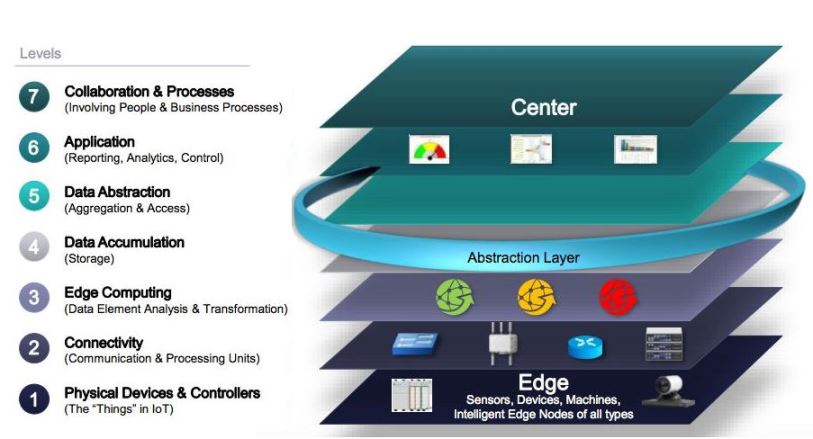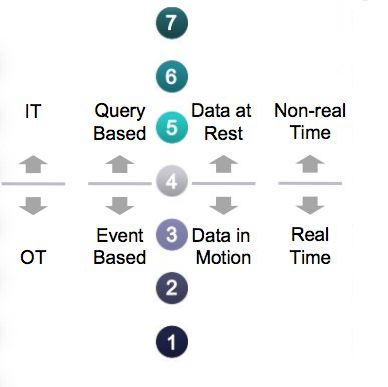How does the IoT really change the future of commercial building operations?
|
November 2014 |
[an error occurred while processing this directive] |
|
The Cutting-Edge of IoT How does the IoT really change the future of commercial building operations? |
The Internet of
Things World Forum just presented its new IoT Reference
Model, recognizing familiar building automation brands as leading in
the category of Edge Computing.
| Articles |
| Interviews |
| Releases |
| New Products |
| Reviews |
| [an error occurred while processing this directive] |
| Editorial |
| Events |
| Sponsors |
| Site Search |
| Newsletters |
| [an error occurred while processing this directive] |
| Archives |
| Past Issues |
| Home |
| Editors |
| eDucation |
| [an error occurred while processing this directive] |
| Training |
| Links |
| Software |
| Subscribe |
| [an error occurred while processing this directive] |
There were a
number of Internet of Things (IoT) community gatherings
held this October — GE’s
Minds & Machines, the IoT World Forum and
GigaOm’s Structure Connect — to name just those
with members of the
Industrial Internet of Things Consortium as headliners. GE,
Cisco, IBM and Intel took to the podiums, often showing their support
for the IoT Reference Model covered here. What are
the important
takeaways for commercial buildings automation?
The model breaks down into seven functional levels the dozens of
technologies that, all combined, comprise the IoT: Devices send and
receive data interacting with the Network
where the data is
transmitted, normalized, and filtered using Edge Computing before
landing in Data storage / Databases
accessible by Applications
which
process it and provide it to people
who will act and collaborate. The
IoT Reference Model emphasizes Edge Computing — all the processing that
is expected to happen at the ‘Thing’ level, that is among all the
physical devices and controllers that now have microprocessors to
‘think’ and radios to ‘talk’ to one another.

Sometimes Cisco
has called this Fog Computing, playing on a
meteorological metaphor that draws a contrast with Cloud Computing.
It’s true, when devices use their data sharing and decision-making
capabilities to work together to suppress what is extraneous and
prioritize what is important, only select data makes it into the
Central data stores of Level 4 for further processing in the cloud.
It’s not practical to transport, store and centrally process all the
sensor data that can be collected from a typical piece of industrial
equipment, and there are obvious response-time, reliability and
security advantages to processing locally. Moreover, while it’s clear
that sensor-equipped edge devices can generate data much faster than
cloud-based apps can ingest it, the differential between the two modes
is unknown and varies depending on application. ‘Edge Software’ is the
name the model gives to any module that has evolved to configure,
address and directly process and temporarily store device data.
The Tridium Niagara framework, DGLogik graphics visualization software
and a number of telemetry provisioning toolsets were recognized during
the IoTWF presentation as pioneers in the Edge Software category. The
model also specifies a layer of abstraction between such Edgeware and
Cloud applications because there is so much variability above and below
to cope with. It calls this layer IoT Middleware and counts on it to
deliver agility and scalability and eventually interoperability.
The IoT events mentioned above had a wide industrial scope and were not
opportune for explaining how the IoT Reference Model can be used to
describe IoT-era information flows in the context of data-driven
Commercial Buildings, so I’ll take that opportunity here.
The careful wording of Data Element Analysis at the Edge and
post-data-cleansing Analytics in the Cloud recall the instructive
article by John Petze of SkyFoundry from May 2013, “Analytics, Alarms,
Analysis, Fault Detection and Diagnostics: Making Sense of the
Data-oriented Tools Available to Facility Managers.” As Petze lays it
out, it is useful to look at all these categories of data tools in
terms of data scope and processing location. Basic BAS system alarms
typically evaluate a sensor versus a limit, referencing one specific
point identified to the BAS system. They have narrow data scope and
react in near real-time with local processing at the device level.
There are now new controller products equipped with sophisticated
analytics engines that still do local, real-time processing, while also
tracking events against business and operational rules, thus offering a
historical perspective. In fact, Tridium just announced Niagara
Analytics Framework, a new data analytics engine native to the Tridium
Niagara controller that does just that. Another example of products
with analytics at the embedded-device level is the line of controllers
and IoT products from Intellastar.
The Petze article makes the distinction between the alarms and
analytics categories this way: “While an alarm might tell us our
building is above a specific KW limit right now, analytics tells us
things like how many hours in the last 6 months did we exceed the
electrical demand target? And how long were each of those periods of
time, what time of the day did they occur and how were those events
related to the operation of specific equipment systems, the weather or
building usage patterns.”
Edge Computing offers the promise of greatly improving the
signal-to-noise in results from another category of tool identified by
Petze - automated Fault Detection and Diagnostics. In a Building IoT
scenario, downstream terminal devices such as VAVs and other boxes
would message amongst themselves to determine if there is a problem
with their parent AHU and thus stop themselves from triggering hundreds
of extraneous faults. Tomorrow’s analytics will build on the ability to
capture such hierarchical structure in tagging conventions set by
industry standardization efforts like Project Haystack. Another good
reason to consider attending Haystack Connect 2015 next May.
Niagara Analytics Framework and Intellastar among others fulfill the
Edge Software role described by the IoT Reference model. There is yet
one more type of analytics software, this with Wide Data Scope, taking
in multiple data sets from sources beyond controller data, such as
energy data, occupancy data, weather sources, etc. The scope might also
widen to include security system or lighting data or personal
identifiers such as the data from location services built into mobile
devices such as the Apple iBeacon system. (Real estate leaders
reveal great enthusiasm for mobile connectivity investment in general
and location-aware technology in particular in recent interviews.)The
wider the data scope, the more sophisticated a device can be in terms
of controlling processes, executing rules and processing data.The
processing location can be local as long as the device executing the
rule can receive the data from contributing sources in a protocol it
understands. To date, many wide-data-scope analytics have featured
processing in the cloud because the real-time aspect was not a driving
concern.

John Petze’s article does emphasize that Building Operational Analytics
is a fast-moving field, and he does include a section on the ability of
analytics to ‘command’ a control system. This section points to
automated demand response as one application for analytics programs
that can drive real-time events across multiple edge devices.
[an error occurred while processing this directive]
As both the 2013 Petze article and the new 2014 IoT reference model
emphasize, analytics tools have to be presented with data in open,
accessible formats by the originating sources. Data collection today is
typically via Bacnet or oBix, Haystack, Modbus, etc., xml (perhaps
Green Button data), CSV file imports, and queries to SQL databases. In
the coming era of IoT, analytics will also collect data via M2M
protocols like MQTT (a messaging protocol) or DDS (peer-to-peer Data
Distribution Service) that were designed for small-device
communications, like sensor events.
The data that does make it ‘north’ moves into the cloud via IoT
Middleware, where it will be accessible by business applications. This
month IBM and Microsoft announced that they are working together to
deliver key IBM middleware such as WebSphere Liberty, MQ, and DB2 on
Azure, Microsoft’s cloud platform. This is an example of
Industrial Internet of Things Consortium members beginning to
collaborate to make this IoT model work. Real estate CTOs and
CFOs should cheer this announcement. For a number of years, they have
been working to consolidate the application software they use, such as
ERP and Workplace Management packages, into integrated IT suites. Now
they can benefit from that unified database architecture and cloud
apps. As Jim Whalen SVP & CIO of Boston Properties explains in a
recent interview, “Now we can move ahead with light mobile apps that
put data visualizations and different types of dashboards at the
fingertips of our tenants and staff.”
[an error occurred while processing this directive]
[Click Banner To Learn More]
[Home Page] [The Automator] [About] [Subscribe ] [Contact Us]